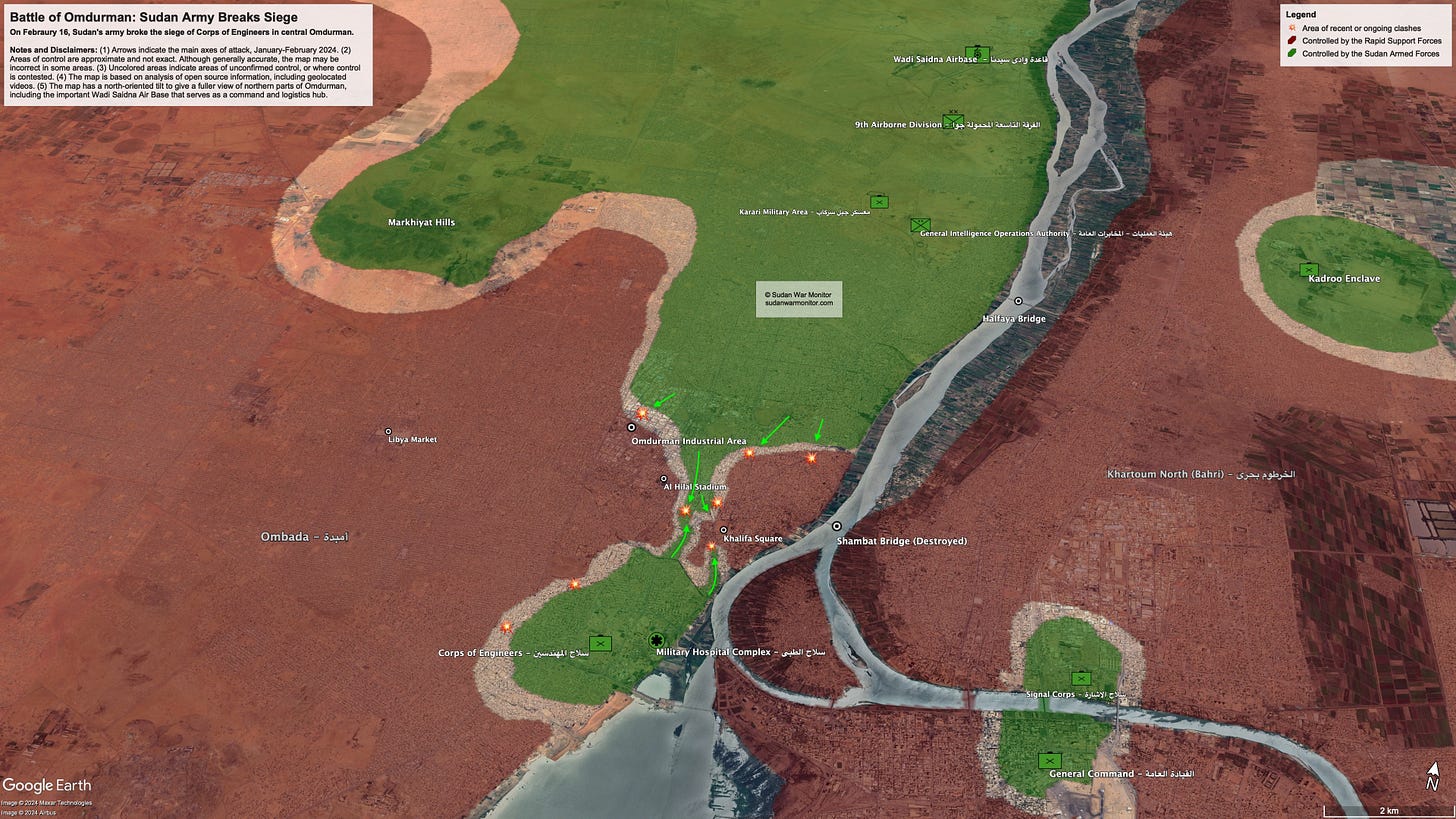Map: Sudan army breaks Omdurman siege
SAF achieves first major offensive success of the war
Sudan’s war has entered a new phase following an army breakthrough in central Omdurman, the nation’s largest city, late last week. The breakthrough relieves the 10-month siege of a military district known as Corps of Engineers, and it represents the army’s first major offensive success of the war.
Geolocated videos from Omdurman show jubilant troops from the army’s so-called Karari Army, based in the north of Omdurman, meeting up with the Engineers Army, based in the central city.
Celebrations were reported throughout army-controlled parts of Omdurman.
Supply trucks and reinforcements immediately began traveling south into the long-besieged military district, effectively ending the Rapid Support Forces’ (RSF) threat to this area, at least for now.
The breakthrough also severs the connection between RSF troops in Ombada and the eastern neighborhoods known as Old Omdurman. Attempts by the army to eradicate RSF resistance in this eastern part of the city could represent the next phase of the Battle of Omdurman. The area is now completely cut off except by river. Although the RSF could deliver supplies or reinforcements by boat from Bahri, this is unlikely to be a sustainable means of defending the area. The Shambat Bridge was destroyed in November in a presumed act of sabotage.
The army’s success in breaking the siege is attributable to the following factors:
Drone-corrected artillery strikes;
Superior logistics and more plentiful ammunition;
Deployment of the army’s most elite units to the area;
Superior manpower;
Precision drone strikes (mostly dropped mortar shells)
Limited use of armoured vehicles;
A more reliable system of pay and benefits;
Urban combat equipment including night vision goggles and tear gas.
The Rapid Support Forces remain in control of large parts of western and southern Omdurman and the western suburb known as Ombada.
This video shows Sudan army troops in central Omdurman, at the breakthrough point, celebrating as supply trucks pass by, heading south.
Background
Sudan’s civil war is the cause of the world’s largest humanitarian crisis. It involves two factions of the same former regime, the dictatorship of Omar al-Bashir, who was deposed by his own generals during popular protests in 2019.
The Sudanese military has suffered major defeats at the hands of the Rapid Support Forces (RSF), a rogue paramilitary, which outmatched it in tactics and maneuver warfare early in the war. However, this latest development raises the army’s hopes of retaking the entire capital using the same tactics of slow, grinding urban warfare.
In the meantime, RSF are threatening to expand the war into new parts of the country. In order to regain the initiative, they may attack the army in Sennar, White Nile, or somewhere unexpected, like Kassala or Dongala.
If the fighting continues, the risk of famine increases. Sudan’s economy has largely collapsed as a result of the war, with millions now out of work and homeless. Downtown government and business districts of the capital Khartoum are gutted and abandoned. Farming in many areas has ceased or was interrupted.
The central government has retreated to the Red Sea city of Port Sudan. What little budget it has left it spends on military equipment and operations. It has few international allies. Eritrea and Iran have emerged as its main military backers, while Egypt, in spite of its historical ties with the Sudanese army, has not intervened. Egypt is currently going through a deep economic crisis of its own. China is also a long-time supplier of military equipment to Sudan, though it isn’t play a political role in the war.
In the absence of government services and a functioning economy, volunteer aid groups called Emergency Rooms have emerged in parts of Sudan. The Emergency Rooms are linked to the nonviolent Resistance Committees of the 2018-2019 popular uprising, having repurposed themselves for humanitarian ends. However, these groups lack funding and at times have been harassed and jailed by the military.
International humanitarian organizations are also operating in parts of Sudan, including Médecins Sans Frontières (Doctors Without Borders), the UN World Food Programme, and the International Organization for Migration, among others.
The long-term international consequences of Sudan’s civil war include large-scale refugee and migrant flows into neighboring countries and beyond, a higher risk of international terrorism, risks to Red Sea shipping, and the spreading of instability into neighboring states, particularly South Sudan and Chad.
In brief
Thank you for reading Sudan War Monitor. You can support our journalism by subscribing for $10/month, or by making a one-time donation. We’re so grateful to the many generous people who have backed this project so far.


